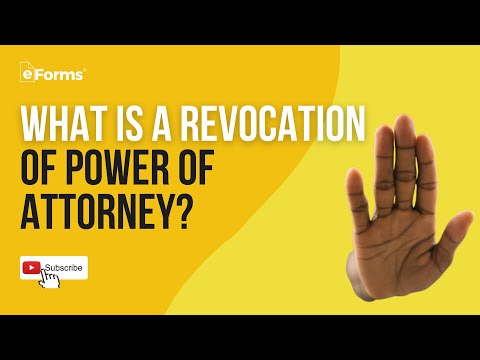
Welcome to this informative article on the topic of “Revoking a Power of Attorney: A Comprehensive Guide for Attorneys”. In this guide, we will explore the intricacies of revoking a power of attorney, providing you with a clear understanding of the legal framework surrounding this important aspect of the attorney-client relationship.
Before we begin, it is crucial to emphasize that this article is not intended as legal advice, but rather as a general overview. It is always advisable to consult with other reliable sources or seek guidance from legal professionals to ensure accuracy and applicability to your specific situation. Now, let us delve into the fascinating world of revoking a power of attorney.
Reversing a Power of Attorney: Key Steps and Considerations
Revoking a Power of Attorney: A Comprehensive Guide for Attorneys
📋 Content in this article
A power of attorney is a legal document that grants someone the authority to act on behalf of another person, known as the principal, in making financial, legal, or healthcare decisions. However, there may be instances where the principal wishes to revoke or reverse the power of attorney. This article will provide a comprehensive guide for attorneys on the key steps and considerations involved in revoking a power of attorney.
1. Understand the Power of Attorney Document:
Before initiating the revocation process, it is crucial to carefully review and understand the terms of the power of attorney document. This document should outline the specific conditions and procedures for revocation. It may specify whether revocation can be done orally or in writing, and if written, whether it requires notarization or delivery to certain individuals.
2. Determine the Type of Revocation:
There are generally two types of revocation: actual revocation and constructive revocation. Actual revocation occurs when the principal explicitly expresses their intent to revoke the power of attorney to the agent and any third parties who may have relied on it. Constructive revocation occurs when the principal takes actions inconsistent with the authority granted under the power of attorney, such as appointing a new agent.
3. Communicate the Revocation:
To ensure that the revocation is properly recognized, it is essential to communicate the revocation to all relevant parties. This typically includes notifying the agent named in the power of attorney, as well as any institutions or individuals who have been dealing with the agent on behalf of the principal. It is advisable to provide written notice, especially if the power of attorney document requires written revocation.
4. Record the Revocation:
To create a clear record of the revocation, it is recommended to document the revocation in writing. This can help prevent any misunderstandings or disputes in the future.
Revoke a Power of Attorney in New York: A Comprehensive Guide
Revoke a Power of Attorney in New York: A Comprehensive Guide
A power of attorney is a legal document that authorizes one person, known as the agent or attorney-in-fact, to act on behalf of another person, known as the principal. The agent has the authority to make decisions and take actions as outlined in the power of attorney document. However, there may come a time when the principal wants to revoke or terminate the power of attorney. This guide aims to provide attorneys with a comprehensive understanding of how to revoke a power of attorney in New York.
1. Understand the Power of Attorney Document
Before proceeding with revocation, it is crucial to thoroughly review the power of attorney document executed by the principal. The document may contain specific instructions or limitations regarding revocation. Pay close attention to any provisions that outline the procedure for revoking the power of attorney.
2. Determine the Method of Revocation
In New York, there are several methods available for revoking a power of attorney. The most common methods include:
3. Notify Relevant Parties
Once the revocation has been executed, it is essential to inform all relevant parties involved.
Reflection on “Revoking a Power of Attorney: A Comprehensive Guide for Attorneys”
In the ever-evolving landscape of US law, staying current on legal topics is of utmost importance for attorneys. This is particularly true when it comes to understanding and navigating the intricacies of revoking a power of attorney. As attorneys, it is our duty to provide accurate and up-to-date information to our clients, and this comprehensive guide aims to assist us in this endeavor.
It is crucial to emphasize that while this guide provides a detailed overview of the process to revoke a power of attorney, readers must exercise caution and verify the content within their jurisdiction. Laws and regulations can vary significantly from state to state, and it is imperative to cross-reference the information provided herein with applicable local statutes and case law.
The Power of Attorney
A power of attorney is a legal document granting an individual, referred to as the “principal”, the ability to appoint another person, known as the “attorney-in-fact” or “agent”, to act on their behalf in various legal and financial matters. This can include decisions related to property, finances, healthcare, and more.
The Need for Revocation
There are various circumstances under which revoking a power of attorney may become necessary. Changes in personal relationships, loss of trust, or the principal’s desire to appoint a new agent are common reasons for revocation. Additionally, if the principal becomes mentally incapacitated or passes away, the power of attorney automatically terminates.
Revocation Methods
Revoking a power of attorney requires specific formalities to ensure its validity. Generally, there are two primary methods for revocation:
1. Written Revocation: The principal can draft a written document explicitly stating their intent to revoke the power of attorney. This document should be signed, dated, and notarized.
